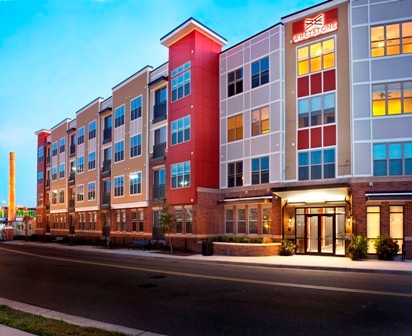Residential densities refer to the number of housing units within a defined area, usually expressed as a number of units per acre. Densities are typically low in suburban settings, where there are more single family houses, and high in urban settings, where there are more apartments. Density ranges are established through a municipality or county zoning ordinance and determine where certain types of housing are appropriate, which has a direct impact on perceived neighborhood character.
Why is this important to your community?
In most cases, municipal and county zoning codes are written with the expectation that residential uses should be separate from commercial uses, and located in the suburbs—a carryover from the housing preferences of the last several decades, beginning in the Post WWII Era. In recent years, however, trends have shifted in residential housing market trends, where certain households are seeking smaller housing types—such as apartments, condominiums, and single-family homes on small lots—located in urban settings, in walking distance to jobs, cultural resources, and entertainment, and without the commute or cost and maintenance responsibilities of a larger property. This trend corresponds with the national re-urbanization of downtown areas, which suffered from disinvestment and neglect in prior decades, as well as transit-oriented development (TOD) trends, as many communities are re-establishing transit systems to reduce traffic congestion and air pollution. To answer this demand, many cities and first suburbs are amending their zoning codes to allow higher density residential and mixed use development in downtowns and urban neighborhoods to accommodate modern housingtypes. The overall goal is to ensure that all housing needs and preferences are met, so low-density and rural character remains to be allowed where appropriate.
Where is it appropriate to use?
What priorities does it address?
What other tools are related?
How does it work?
Residential density is dictated by the zoning code and the development regulations associated with the districts shown on the zoning map. Most communities have established zoning districts for a range of residential categories and non-residential uses, as well as mixed use districts that accommodate both. In addition, zoning codes allow for “overlays” which may be enacted in addition to the underlying use regulation to achieve a certain type of development form or character. Overlays may be established to protect historic resources, maintain neighborhood character, or create a district dictated by a site-specific master plan. Writing a zoning code, sometimes called a development ordinance, is a lengthy and time-consuming process so communities only update the code periodically. To achieve appropriate residential densities that reflect current market trends and that align with existing or proposed transportation and employment systems requires supporting plans. For example, a comprehensive plans establish locations for desired densities throughout a city through a future land use map and overarching vision principles, sub-area plans examine a smaller area in detail to determine appropriate development types, and station area plans define land use patterns and densities specifically around transit station locations. Ideally, a Community-Based Housing Strategy serves as the basis for expected population growth and the types of housing units that are needed to serve a community’s future population.
Ready to get started?
Using the Tool
- Create a stakeholder group to advise on changes to the land use plan, zoning code, or other document that will potentially result in housing density changes. While the stakeholder group does not need to run the process, they should be kept in the loop with findings and allowed opportunities throughout the process to provide input. Orient the stakeholder group with a review of long-term community priorities, and get their input on those.
- Review population projects and regional trends, and conduct a Community-Based Housing Strategy to determine the type of housing that is needed in the community for the next several decades (20-30 years).
- Review the most recent Comprehensive Plan to review goals and policies that call for compact development, mixed use development, transit and job accessibility, and walkable and bicycle-accessible neighborhoods. If the Comprehensive Plan has not been updated in the last five years, ensure that the plan is updated with a rigorous public engagement process to ensure that community desires for housing, transportation, and amenities are captured.
- Review the Future Land Use Map for the city, town, or county to review locations for residential development and if they are matching with the specified housing needs of the community.
- Revise the zoning code to ensure that residential districts allow for the type of densities that will support the creation of apartments, condominiums, and townhomes in an urban format, as well as traditional single-family areas and suburban neighborhoods. Match the desired housing types within the community aspirations expressed through the Comprehensive Plan and as reflected through the housing needs assessment.
- Include form-based guidelines in the zoning code to ensure that higher-density development in downtown and urban areas include requirements for streetscape orientation, dedicated open space, public amenities, transit accessibility, and parking standards to produce desired urban character.
- If a comprehensive rewrite of the zoning code is not an option, review the zoning code for the option to propose a Traditional Neighborhood Development (TND) or Planned Unit Development (PUD) to introduce unique zoning districts in a specified area to allow for the desired range of housing densities.
- In any approach, engage the public at key points as you go and ensure that you abide by all legal requirements for hearings and notices.
Partners
Where has it worked?
Baxter Village - Fort Mill, SC
 Image Source: Baxter Village Development & Clear Springs Development Co..
Image Source: Baxter Village Development & Clear Springs Development Co..
Contact
Clear Springs Development Co.
951 Market St. Ste. 203, Fort Mill, SC 29708
(877) 570-HOME
About the Program
Baxter Village is a community on the edge of Fort Mill’s city limits in York County, South Carolina. Baxter Village lies at the juncture of I-77 and Highway 160 on property owned by the Close Family, developed with the intention of creating a new type of living experience in Fort Mill. The neighborhood was developed in the early 2000s in the New Urbanist style of development, which endeavors to recreate “traditional” neighborhoods with businesses and services and neighborhood services (i.e. schools, libraries, places of worship) located in a town center in walking distance to homes, complemented by parks and recreation facilities in close proximity. Including a range of housing types and price points is also a goal of traditional neighborhood development, so that all are welcome to live, shop, and recreate there. Because it was introducing land use types and densities that were not found elsewhere in the county, the development was created through the adoption of a Traditional Neighborhood Design (TND) zoning overlay district with York County, SC. Today it includes a YMCA, the Fort Mill Public Library, Orchard Park Elementary School, Piedmont Urgent Care Center, and the Baxter Town Center with a diversity of businesses to serve the community and the city as a whole.
Why it works
The York County Zoning Code contains a Traditional Neighborhood Design (TND) zoning district which promotes greater flexibility of land uses and densities than other zoning districts within the county. Many communities have such allowances in their zoning codes, either as TNDs or as PUDs (Planning Unit Development). The creation of such a district requires a rezoning application provided to the county, including the development program for the site and a pattern book, containing architectural guidelines. The development program also includes locations of different housing typologies of varying sizes and densities, such as apartments and condominiums, residential above commercial uses in a mixed use format, townhouses, and single-family homes in a range of sizes. This enables the combination of a variety of housing types into one neighborhood to promote housing diversity and a community consisting of a range of household types and sizes. The TND also includes locations for commercial development and street and public realm standards to achieve the compact neighborhood feel. Once adopted, development review for the area falls to the zoning administrator who then references the pattern book and regulations contained in the TND overlay. This tool is useful for creating a diversity of housing types in a suburban setting and offers opportunities for transit and bicycle connectivity, jobs within close proximity of housing, and balanced, diverse communities.
Unified Development Ordinance (UDO) - Durham, NC
About the Program
The City of Durham updated and adopted its Unified Development Ordinance (UDO) in 2006, which lays the rules for the physical development of properties throughout the city. The UDO was crafted to result in a built environment that meets the goals of the City’s Comprehensive Plan. As such the UDO recommends residential densities throughout the city to support goals for compact development, rebirth of the Downtown, transit-oriented development, and to promote walkability. The UDO supersedes the Zoning and Subdivision Ordinances of the City and has resulted in the creation of several successful residential and mixed-use projects in the downtown and near jobs centers such as Duke University, while protecting and strengthening existing neighborhoods, and allowing for a range of housing types to match housing choice. Districts in the UDO correspond to the Zoning Map and guide all development review in the city. The UDO was recently amended in 2014, so it is kept current with national housing trends and the City’s recent update to its Comprehensive Plan in 2012.
Why it works
As one of the most quickly growing areas of the nation, the Raleigh-Durham-Chapel Hill Combined Statistical Area (CSA), Durham is on the forefront of working with tools to manage growth and maintain quality of life. With an economy fueled by research and education, current and future residents of Durham seek a high-quality lifestyle, with many choosing to live in compact settings with access to walking, transit, and open space. The City of Durham recently updated its Comprehensive Plan in 2014, and put forward a land use pattern reflecting its growth and accommodating a variety of housing and density types. The Future Land Use Map was created under the guiding framework of “development tiers” which captured the land use goals of the Plan to accommodate different community types and aligning land use and transportation. The Tiers included a Downtown Tier to activate Downtown Durham and promote pedestrian- and transit-oriented development, a Compact Tier to spark growth their planned transit stations, where development would be transit-, bicycle-, and pedestrian-oriented with an attention to streetscape design. The Urban Tier protects historic neighborhoods surrounding historic downtown with the intention of maintaining urban form of existing development, while much of the new projected growth in the city would occur in the Suburban Tier, the area of traditional suburban densities and patterns within the urban service area. Finally the Rural Tier at the city’s fringes allows for very low density development that maintains rural character and agriculture and water resources. These development tiers are reflected in the update to the Unified Development Ordinance (UDO), which establishes zoning districts to match the intent of the Development Tiers. In Downtown, the Downtown Design District – Core (DD-C) and Downtown Design District – Support 1and 2 (DD-S1, DD-S2) districts encourage the highest degree of density and intensity in the city. The Residential Compact (RC) district, focused on growth areas area transit, allows for 12-53 du/ acre in its Core areas (RC-C) and 6-20 du/acre in the less intense Support district (RC-S). Residential Urban (RU) districts match appropriate densities associated with the Urban and Suburban Development Tiers. Each district contains form-based development regulations for streetscape character, required open space dedication, public amenities, and a density bonus for workforce housing.
http://durhamnc.gov/ich/cb/ccpd/Pages/Durham-Unified-Development-Ordinance.aspx



